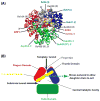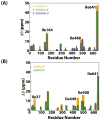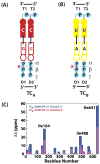Slow conformational dynamics in the cystoviral RNA-directed RNA polymerase P2: influence of substrate nucleotides and template RNA
- PMID: 21244027
- PMCID: PMC3059373
- DOI: 10.1021/bi101863g
Slow conformational dynamics in the cystoviral RNA-directed RNA polymerase P2: influence of substrate nucleotides and template RNA
Erratum in
- Biochemistry. 2011 May 3;50(17):3578
Abstract
The RNA-directed RNA polymerase P2 from cystovirus ϕ6 catalyzes the de novo synthesis of positive and negative strands of the viral double-stranded RNA genome. P2 is mobile on the slow, microsecond to millisecond time scale with various motional modes, putatively assisting in RNA translocation and catalysis. Here we investigate the influence of the extreme 3'-end sequence of the single-stranded RNA templates and the nature of the substrate nucleotide triphosphates on these motional modes using multiple-quantum NMR spectroscopy. We find that P2, in the presence of templates bearing the proper genomic 3'-ends or the preferred initiation nucleotide, displays unique dynamic signatures that are different from those in the presence of nonphysiological templates or substrates. This suggests that dynamics may play a role in the fidelity of recognition of the correct substrates and template sequences to initiate RNA polymerization.
Figures






Similar articles
-
Cystoviral polymerase complex protein P7 uses its acidic C-terminal tail to regulate the RNA-directed RNA polymerase P2.J Mol Biol. 2014 Jul 15;426(14):2580-93. doi: 10.1016/j.jmb.2014.04.028. Epub 2014 May 9. J Mol Biol. 2014. PMID: 24813120 Free PMC article.
-
Cystoviral RNA-directed RNA polymerases: Regulation of RNA synthesis on multiple time and length scales.Virus Res. 2017 Apr 15;234:135-152. doi: 10.1016/j.virusres.2017.01.006. Epub 2017 Jan 16. Virus Res. 2017. PMID: 28104452 Free PMC article. Review.
-
Structure of the RNA-dependent RNA polymerase P2 from the cystovirus φ8.Sci Rep. 2024 Oct 9;14(1):23540. doi: 10.1038/s41598-024-75213-7. Sci Rep. 2024. PMID: 39384884 Free PMC article.
-
Structure of the RNA-directed RNA polymerase from the cystovirus φ12.Proteins. 2013 Aug;81(8):1479-84. doi: 10.1002/prot.24297. Epub 2013 Jun 1. Proteins. 2013. PMID: 23568335 Free PMC article.
-
Packaging in dsRNA viruses.Adv Exp Med Biol. 2012;726:601-8. doi: 10.1007/978-1-4614-0980-9_26. Adv Exp Med Biol. 2012. PMID: 22297532 Review.
Cited by
-
Methyl Relaxation Measurements Reveal Patterns of Fast Dynamics in a Viral RNA-Directed RNA Polymerase.Biochemistry. 2015 Sep 29;54(38):5828-38. doi: 10.1021/acs.biochem.5b00828. Epub 2015 Sep 17. Biochemistry. 2015. PMID: 26333183 Free PMC article.
-
The Picornavirus Precursor 3CD Has Different Conformational Dynamics Compared to 3Cpro and 3Dpol in Functionally Relevant Regions.Viruses. 2021 Mar 9;13(3):442. doi: 10.3390/v13030442. Viruses. 2021. PMID: 33803479 Free PMC article.
-
Temperature controlled high-throughput magnetic tweezers show striking difference in activation energies of replicating viral RNA-dependent RNA polymerases.Nucleic Acids Res. 2020 Jun 4;48(10):5591-5602. doi: 10.1093/nar/gkaa233. Nucleic Acids Res. 2020. PMID: 32286652 Free PMC article.
-
Cystoviral polymerase complex protein P7 uses its acidic C-terminal tail to regulate the RNA-directed RNA polymerase P2.J Mol Biol. 2014 Jul 15;426(14):2580-93. doi: 10.1016/j.jmb.2014.04.028. Epub 2014 May 9. J Mol Biol. 2014. PMID: 24813120 Free PMC article.
-
Cystoviral RNA-directed RNA polymerases: Regulation of RNA synthesis on multiple time and length scales.Virus Res. 2017 Apr 15;234:135-152. doi: 10.1016/j.virusres.2017.01.006. Epub 2017 Jan 16. Virus Res. 2017. PMID: 28104452 Free PMC article. Review.
References
-
- Poranen MM, Tuma R. Self-assembly of double-stranded RNA bacteriophages. Virus Res. 2004;101:93–100. - PubMed
-
- Ferrer-Orta C, Arias A, Escarmis C, Verdaguer N. A comparison of viral RNA-dependent RNA polymerases. Curr Opin Struct Biol. 2006;16:27–34. - PubMed
-
- Butcher SJ, Grimes JM, Makeyev EV, Bamford DH, Stuart DI. A mechanism for initiating RNA-dependent RNA polymerization. Nature. 2001;410:235–240. - PubMed
Publication types
MeSH terms
Substances
Grants and funding
LinkOut - more resources
Full Text Sources

